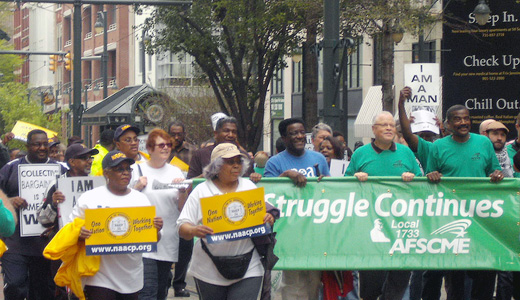
64 years after its passage on June 24, 1947 the Taft-Hartley Act continues to hurt workers.
How did the landmark anti-labor legislation, backed at that time by Joe McCarthy and Richard Nixon, come to be the law of the land?
Earlier, in 1935, union leaders had worked with U.S. Senator Robert Wagner to create a law called the National Labor Relations Act.. Prior to the NLRA being signed into law by President Franklin Roosevelt on July 5, 1935 a legal right to join a union in the workplace did not exist in the United States.
The NLRA actually declared encouragement of collective bargaining to be the policy of the United States government. When Wagner introduced the bill into the Senate he declared: “Democracy cannot work unless it is honored in the factory as well as the polling booth.”
The NLRA made it illegal for bosses to fire or discriminate against workers who organized or supported unions.
During World War II workers and their unions sacrificed wage and benefit increases but when the war was over auto workers, meat packers, steel workers and others wanted a fair share of the then rapidly growing profits raked in by their bosses. Employers began crushing unions by, among other things, backing candidates for public office who would undo the progressive legislation of the New Deal, including the NLRA.
In the 1946 mid-term election the Republicans won control of both houses of Congress.
Once in office, their first target was the NLRA. They enlisted, and got the support of a big section of the Democrats in Congress, the so-called Dixiecrats who supported racial segregation. The bill that Sen. Robert Taft of Ohio and Rep. Fred Hartley of New Jersey finally pushed through Congress effectively gutted the NLRA and President Harry Truman, over whose veto the measure was passed, called it “the slave labor bill.”
It banned the closed shop (made it illegal for employers to hire only union members), allowed states to outlaw union shops, prohibited secondary boycotts and sympathy strikes, allowed employers rather than workers the right to decide how unions would be formed at the workplace, and required that all union officials pledge that they were not communists. (This part of the law was ruled unconstitutional in 1965.)
Taft-Hartley had an immediate negative effect on unions.
Only a year before it was passed, the CIO had begun Operation Dixie, a massive effort to unionize Southern workers in the cotton textile production industry.
Passage of Taft-Hartley ensured the defeat of the organizing campaign and when it was halted in 1953 only 15 percent of Southern textile workers had been organized. It wasn’t until 1963 that an effort to unionize at the J.P. Stevens Company would begin again and it took 17 years for that struggle to end in victory.
There is much to be learned from the passage of Taft-Hartley.
First, labor benefits when it fights for unity and for an end to discrimination. The bill itself could only be passed because in 1947 African Americans in the South were effectively still denied the right to vote.
Southern lawmakers said they had to stop union organizing because if unions succeeded it would set the stage for elimination of racial segregation. Today the South continues as the least unionized section of the country and remains, even among some modern day Democratic Party politicians, the focal point of opposition to pro-union bills like the Employee Free Choice Act.
A second lesson for today from the passage of Taft-Hartley is the need to stand up to witch-hunts and fear mongering. Joe McCarthy and Richard Nixon both got elected to Congress in 1946 as anti-Communist witch hunters and in 1947, by supporting Taft-Hartley, they showed what they were really about. How many tea party candidates today do they remind us of?
A third lesson is that when the right wing attacks we must be ready to throw out our old approaches and consider new and bold ways of fighting. In 1947 the labor movement too often played defense, trying to hold onto the gains of the Roosevelt years instead of taking up new challenges coming from the right.
Commenting on the passage of the Taft-Hartley law, 64 years ago, Eleanor Roosevelt said, “Instead of clamping down on the labor movement, Americans should be extremely grateful to unions.”
It seems that the biggest lesson to be learned is that Eleanor Roosevelt’s message is relevant today and must be shouted out across the land.
Judging from what’s happened in Wisconsin and what is happening from one end of the country to the other, that lesson may have finally been learned.
Photo: April 4, 2011, Memphis, Tenn. People’s World












Comments